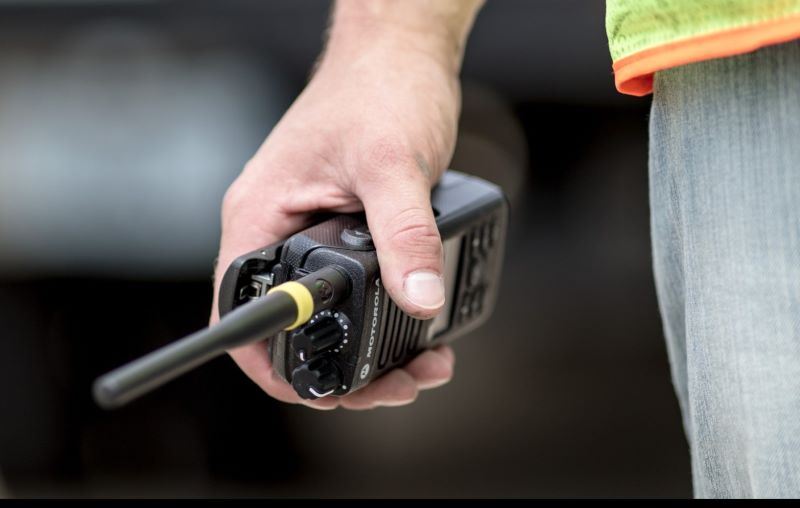
 Released On 6th Dec 2022
Released On 6th Dec 2022
Tips to extend the battery life of your two-way radio
What affects your two-way radio’s battery life, how long should the battery last, and how can you extend it for maximum performance long-term?
Losing radio communication half-way through a work-shift doesn’t just have repercussions on efficiency, it can make team members vulnerable in an emergency. Coaxing the best performance from your two-way radio’s battery will extend its life to help you maintain critical communications.
How long do two-way radio batteries last?
There are two answers to this question:
- Battery capacity will decrease naturally over time. Never-the-less, you should expect a good battery to last at least an 8-hour shift between charges with “normal” use, and up to a day between charges with lighter use. It will depend on various factors, though, such as:
- Is your radio used more intensively than the typical 5:5:90 cycle (see below)?
- The quality of the battery (cheaper batteries can sometimes be a false economy)
- The type of battery used, e.g. lithium ion vs NiMH (more about this later)
- Higher wattage radios use more battery power, which uses up the battery charge more quickly
- The average total lifespan of a two-way radio battery may fall somewhere between 18 and 24 months, depending on the quality of the battery and how frequently it’s used.
If any of those mitigating factors apply to you, you might need to invest in a more advanced battery. We’re happy to advise customers about their options.
Battery Life and the 5-5-90 duty cycle
You might have read about the 5:5:90 duty cycle on the information leaflet that came with your radio battery. What does this industry term mean?
Essentially, your radio has three states:
- Transmitting, when you're sending a message
- Receiving, when you're receiving a transmission
- Standby, when the radio is idle, monitoring channels, but is neither receiving or transmitting.
The 5:5:90 duty cycle assumes that most people spend 5% of the time transmitting, 5% receiving, and the radio will be on standby the other 90% of the time.
Whatever battery life your radio equipment manufacturer claims for your battery, they are probably based on a typical 5:5:90 duty cycle.
If your typical transmitting and receiving times are too far outside these norms, its charge will deplete more quickly. If this is a regular problem, it might be better to purchase a higher capacity battery. Ask our experts to guide you to a suitable product for your radio.
Do lithium-ion batteries perform better than NiMH batteries?
Yes. Li-ion (lithium-ion) batteries have one of the highest energy densities of any battery type, delivering around three times the output of an NiMH (nickel metal hydride) battery.
Li-ion batteries also suffer much less from “memory effect”, which can reduce the ability of a battery to hold a full charge over time.
There’s also something called “self-discharge”, which is when a battery loses charge over time, even when it’s not being used. Lithium-ion batteries self-discharge at a much lower rate than NiMh batteries. This might be a factor if your two-way radios get infrequent use, and you need some confidence the batteries will still be adequately charged when you come to use them again.
Read our article about Li-ion vs NIMH batteries, which covers this topic in more detail.
Practical tips for battery maintenance
- Before using a new two-way radio battery for the first time, fully charge it overnight. This is called “initialising”, and it helps the battery reach its full capacity.
- Remove the battery from the radio completely if it is not going to be used for a while, and store it in a cool place. This reduces drain, and the self-discharge phenomenon we described above. It may also prolong a lithium ion battery’s life to store it at a state of charge of around 40%, rather than fully charged.
- Check your battery’s storage conditions. For maximum longevity, the optimum environment is well ventilated, with a temperature range between 20°C and 30°C, and humidity between 30% and 60%.
- Fully discharge and recharge a battery if it has been in storage for more than two months. You might need to do this several times for the battery to get back to peak charging capacity. If the battery cells are too old, however, this method becomes less effective.
- Try not to recharge a battery unless it is fully discharged, as doing so exacerbates the memory effect that some types of battery suffer from. The exception to this is for lithium-ion batteries - see our next point.
- Lithium-ion batteries don’t experience the memory effect to nearly the same degree as others, but experts advise that even Li-ion batteries should be almost fully discharged every 30 cycles or so before recharging.
- Don’t use the charger as a radio stand, and don’t leave a fully charged radio in the charger. Over-charging your radio batteries will actually shorten their life-span.
- Respect your radio battery’s dust and water IP rating. Using your radio in conditions in which it’s not built to operate can cause permanent damage, or at the very least, shorten its life.
While these tips will help you enjoy a longer battery life, whether a battery is in daily use, or being stored as a spare, it will deteriorate over time. It’s important to remember this when you are buying a new battery for your two-way radio - check the manufacture date; you don’t want one that’s been languishing in a warehouse for a year or more.
Shop for a new battery for your two-way radio, or get in touch if you’d like our help or advice.
 7th Sep 2022
7th Sep 2022
 Released On 6th Dec 2022
Released On 6th Dec 2022 7th Sep 2022
7th Sep 2022 23rd Aug 2022
23rd Aug 2022